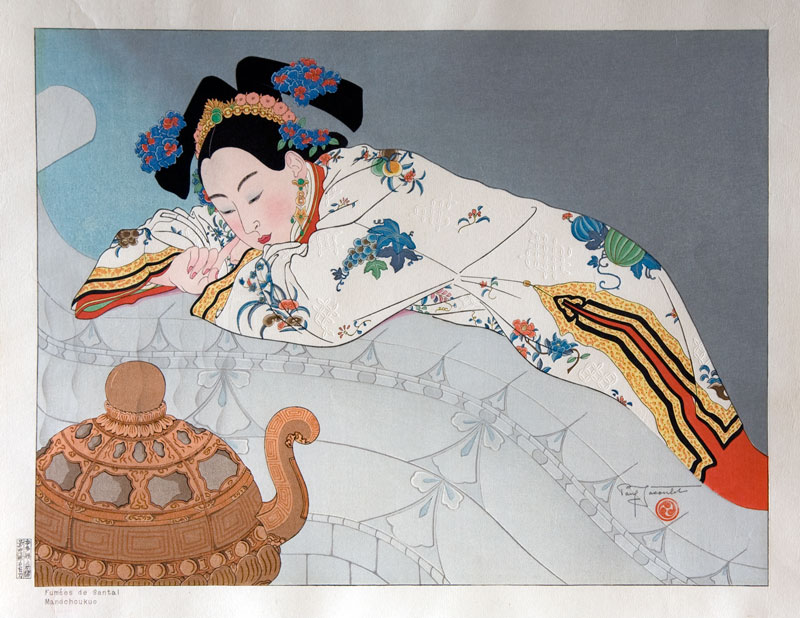Shin Hanga prints
| Design: | Paul Jacoulet (1896-1960) | |||||
| Title: | Fumées de santal. Mandchoukuo. | |||||
| Size: | 29.9 x 39.2 cm (dai ōban) | |||||
| Original woodblock print | ||||||
| Photography: | Jacques Commandeur |
|

|
Special effects: silver mica background, karazuri (which is Japanese for the technique of embossing or blind printing in English, and for gauffrage in French) on gown, and silver metallics on hair ornaments and gown.
Published on 25 December 1948.
Impression number 159 out of 350 on verso of the print:

|
Watermark with ‘PJ’ in romaji and ‘若礼’ (i.e., Jakurei) in kanji in left margin.
Paul Jacoulet signature in black pencil and red mitsu-domoe seal in bottom right of the print. ‘Fumées de Santal’ is the only print where Paul Jacoulet used the mitsu-domoe seal, whose black version, moreover, is apparently used as the favicon of the Hanga Online website.
Names of carver and printer in left margin:
| Character | Translation | Character | Translation |
| 前 | 本 | ||
| 田 | Maeda | 多 | Honda |
| 謙 | 鉄 | ||
| 太 | 之 | ||
| 郎 | Kentarō | 助 | Tetsunosuke |
| 刀 | Carver | 摺 | Printer |
Print title in left bottom margin: Fumées de Santal Mandchoukuo
On this print Richard Miles (1982) comments: ‘This is one of Jacoulet’s most successful yoko-e or horizontal compositions. The traditional gauffrage on the brilliantly composed gown is one of his best effects in combination with the pale grey and blue tile that seems as soft as a pillow. The grey smoke of the burning sandalwood undulates from the Ch’ing dynasty incense burner.’
Original text in French given by Jacoulet to all buyers of this print (Jacoulet, 2020): ‘FUMÉE DE SANTAL. Une dame de la Court est allongée sur la rampe d’un escalier de marbre au bas duquel un brûle parfum d’où s'échappe une légère fumée de santal. Les yeux mi-clos elle rêve... Les ongles de ses mains ont été rosis avec des pétales de balsamine appliqués pendant la nuit. De belles boucles de jade et d'or alourdissent ses oreilles. Sur sa tête une couronne dorée retient un grand ruban laqué orné de fleurs. Une robe blanc papier gaufre, decorée de fruits et fleurs multicolores aux nervures or et argent, recouvre le vêtement rouge écarlate. Des lignes rendent admirablemet les plis de la robe.
Cette gravure à été dediée a S.M. le Roi Georges VI. Le Hang représente trois porte-bonheur qui se pousuivent.’
References
- Jacoulet, Paul (2020). Paul Jacoulet. The complete woodblock prints. ポール・ジャクレー全木版画集. Tokyo: Abe Publishing LTD.
- Miles, Richard (1982). The prints of Paul Jacoulet. Pasadena: Pacific Asia Museum.
- Polak, Christian, et Sawatari, Kiyoko (2013). Un artiste voyageur en Micronésie. L’univers flottant de Paul Jacoulet. Musée du quai Branly, Paris: Somogy éditions d’art.
- The rainbow artist Paul Jacoulet (2003). Yokohama: The Yokohama Museum of Art.
- Wells, Florence G. (1957). Paul Jacoulet, Wood-Block Artist. Tokyo: Foreign Affairs Association of Japan.
Provenance: Castle Fine Arts


